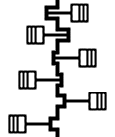|
|
Six-cylinder Boxer Engine
As far as the timing is concerned, all six-cylinder engines work the same. If we e.g., look at the power stroke of one cylinder, we see that during the first- and the last 60° another cylinder is also working. In the interim
period, it alone powers the engine. One speaks of a 120° firing interval.
The crankshaft is very similar to hat of the six cylinder in-line engine, except that the big-end bearings are
differently distributed and that the counterweights may be
missing. Thus, the two front crankpins in the in-line engine, lie right in front and right at the back. Indeed, also in this case, there are two each on the far left and right, two at the top right and the bottom left and two at the
top left and the bottom right.
By the way, the engines do not differ in their mass forces and momentum. From this point of view, the more complex construction of the boxer-engine is not really justified. It only makes sense, because of the shorter
design, when straight-mounted, in Porsche with only little rear- and Subaru with only little front-overhang. With a mid-engine there is less space lost
between the axles. An unequalled second advantage is the vehicle's low centre of gravity.

The crankshaft with crankpins in three levels, makes it possible to move the individual pistons. Three opposite each other lying pistons on either side, move
either towards- or away from
each other. The crankshaft has mostly seven bearings. One example of the firing order: 162435. 04/09
|
|